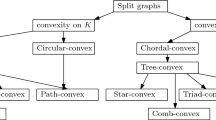Abstract
The well-known Disjoint Paths problem takes as input a graph G and a set of k pairs of terminals in G, and the task is to decide whether there exists a collection of k pairwise vertex-disjoint paths in G such that the vertices in each terminal pair are connected to each other by one of the paths. This problem is known to be NP-complete, even when restricted to planar graphs or interval graphs. Moreover, although the problem is fixed-parameter tractable when parameterized by k due to a celebrated result by Robertson and Seymour, it is known not to admit a polynomial kernel unless NP ⊆ coNP/poly. We prove that Disjoint Paths remains NP-complete on split graphs, and show that the problem admits a kernel with O(k 2) vertices when restricted to this graph class. We furthermore prove that, on split graphs, the edge-disjoint variant of the problem is also NP-complete and admits a kernel with O(k 3) vertices. To the best of our knowledge, our kernelization results are the first non-trivial kernelization results for these problems on graph classes.




Similar content being viewed by others
Notes
We briefly sketch a reduction from Edge-Disjoint Paths on general graphs to Edge-Disjoint Paths on line graphs. Replace every edge uv of the original graph G by a three-vertex path u,x u v , v (where x u v is a new vertex), and take the line graph of the resulting graph. Then each edge uv of G corresponds to an edge of the line graph (namely, the edge between the vertices corresponding to edges u x u v and x u v v). This creates a correspondence between paths in G and paths in the line graph, and completes the proof.
We mention, however, that our polynomial kernel for Edge-Disjoint Paths, presented in Section 4.2, can be easily modified to take this restriction into account. It suffices to insist in Lemma 8 that, instead of the degree, the number of non-terminal neighbors is at least the number of terminals on it. The rest of the proof goes through (mutatis mutandis). Also, our NP-completeness result is not influenced by this issue.
References
Bodlaender, H.L., Downey, R.G., Fellows, M.R., Hermelin, D.: On problems without polynomial kernels. J. Comp. Syst. Sci. 75(8), 423–434 (2009)
Bodlaender, H.L., Fomin, F.V., Lokshtanov, D., Penninkx, E., Saurabh, S., Thilikos, D.M.: (Meta) kernelization: In: 50th Annual IEEE Symposium on Foundations of Computer Science, FOCS 2009, pp. 629–638. IEEE Computer Society (2009)
Bodlaender, H.L., Thomasse, S., Yeo, A.: Kernel bounds for disjoint cycles and disjoint paths. Theor. Comp. Sci. 412(35), 4570–4578 (2011)
Brandstädt, A., Le, V.B., Spinrad, J.: Graph Classes: A Survey SIAM Monographs on Discrete Mathematics and Applications (1999)
Diestel, R.: Graph Theory. Springer-Verlag, Electronic Edition (2005)
Downey, R.G., Fellows, M.R.: Parameterized Complexity. Monographs in Computer Science. Springer (1999)
Dvorak, Z., Král’, D., Thomas, R.: Three-coloring triangle-free planar graphs in linear time. In: Mathieu, C. (ed.), SODA 2009, pp. 1176–1182. ACM-SIAM (2009)
Even, S., Itai, A., Shamir, A.: On the complexity of timetable and multicommodity flow problems. SIAM J. Comp. 5, 691–703 (1976)
Frank, A.: Packing paths, circuits, and cuts – a survey. In: Korte, B., Lovász, L., Prömel, H.J., Schrijver, A (eds.) Paths, Flows, and VLSI-Layout, pp. 47–100. Springer-Verlag, Berlin (1990)
Golumbic, M.C.: Algorithmic Graph Theory and Perfect Graphs. Annals of Disc. Math. 57. Elsevier (2004)
Gurski, F., Wanke, E.: Vertex disjoint paths on clique-width bounded graphs. Theor. Comput. Sci. 359, 188–199 (2006)
Hammer, P.L., Simeone, B.: The splittance of a graph. Combinatorica 1, 275–284 (1981)
Heggernes, P., van ’t Hof, P., van Leeuwen, E.J., Saei, R.: Finding disjoint paths in split graphs. In: Geffert, V., Preneel, B., Rovan, B., Stuller, J., Tjoa, A.M. (eds.) SOFSEM 2014. LNCS, vol. 8327, pp. 315–326 (2014)
Kammer, F., Tholey, T.: The k-disjoint paths problem on chordal graphs. In: Paul, C., Habib, M. (eds.) WG 2009. LNCS, vol. 5911, pp. 190–201 (2010)
Karp, R.M.: On the complexity of combinatorial problems. Networks 5, 45–68 (1975)
Kawarabayashi, K., Kobayashi, Y., Reed, B.A.: The disjoint paths problem in quadratic time. J. Comb. Theory B 102, 424–435 (2012)
Kobayashi, Y., Kawarabayashi, K.: Algorithms for finding an induced cycle in planar graphs and bounded genus graphs. In: Mathieu, C. (ed.), SODA 2009, pp. 1146–1155. ACM-SIAM (2009)
Kramer, M., van Leeuwen, J.: The complexity of wirerouting and finding minimum area layouts for arbitrary VLSI circuits. Adv. Comput. Res. 2, 129–146 (1984)
Lynch, J.F.: The equivalence of theorem proving and the interconnection problem. ACM SIGDA Newsl. 5(3), 31–36 (1975)
Natarajan, S., Sprague, A.P.: Disjoint paths in circular arc graphs. Nordic. J. Comp. 3, 256–270 (1996)
Nishizeki, T., Vygen, J., Zhou, X.: The edge-disjoint paths problem is NP-complete for series-parallel graphs. Discret. Appl. Math. 115, 177–186 (2001)
Reed, B.A.: Tree width and tangles: A new connectivity measure and some applications. In: Bailey, R.A. (ed.) Surveys in Combinatorics, pp. 87–162. Cambridge University Press, Cambridge (1997)
Reed, B.A., Robertson, N., Schrijver, A., Seymour, P.D.: Finding disjoint trees in planar graphs in linear time. In: Contemporary Mathematics. American Mathematics Social, Providence, RI, vol. 147, pp. 295–301 (1993)
Robertson, N., Seymour, P.D.: Graph minors XIII. The disjoint paths problem. J. Comb. Theory B 63(1), 65–110 (1995)
Tovey, C.A.: A simplified NP-complete satisfiability problem. Discret. Appl. Math. 8, 85–89 (1984)
Vygen, J.: Disjoint paths. Technical report 94816, Research Institute for Discrete Mathematics. University of Bonn (1998)
Author information
Authors and Affiliations
Corresponding author
Additional information
This research is supported by the Research Council of Norway. A preliminary version of this work was presented at SOFSEM 2014 [13].
Rights and permissions
About this article
Cite this article
Heggernes, P., van ’t Hof, P., van Leeuwen, E.J. et al. Finding Disjoint Paths in Split Graphs. Theory Comput Syst 57, 140–159 (2015). https://doi.org/10.1007/s00224-014-9580-6
Received:
Accepted:
Published:
Issue Date:
DOI: https://doi.org/10.1007/s00224-014-9580-6




